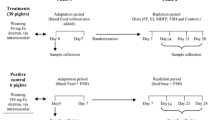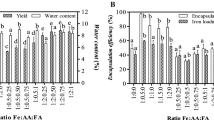Abstract
Background and aims
Food iron (Fe) fortification is an adequate approach for preventing Fe-deficiency anemia. Poorly water-soluble Fe compounds have good sensory attributes but low bioavailability. The reduction of the particle size of Fe fortificants and the addition of ascorbic acid might increase the bioavailability of low-soluble compounds. The present work aims to compare the Fe absorption and bioavailability of micronized dispersible ferric pyrophosphate (MDFP) (poorly soluble) to ferrous sufate (FS) (highly soluble) added to a fruit juice in presence or absence of ascorbic acid (AA) by using the hemoglobin repletion assay in rats.
Methods
After a hemoglobin depletion period, four fruit juices comprised of (1) FS, (2) MDFP, (3) FS + AA, (4) MDFP + AA were produced and administered to a different group of rats (n = 18) over 21 days. During the repletion period, Fe balance, hemoglobin regeneration efficiency (HRE), relative bioavailability (RBV) and Fe tissue content were determined in the short, medium and long term.
Results
Fe absorption and bioavailability showed no significant differences between fortifying the fruit juice with FS or MDFP. The addition of AA to the juice enhanced Fe absorption during the long-term balance study within the same Fe source. HRE and Fe utilization increased after AA addition in both FS and MDFP groups in every period.
Conclusion
Fe absorption and bioavailability from MDFP were comparable to FS added to a fruit juice in rats. Further, the addition of AA enhanced Fe absorption in the long term, as well as Fe bioavailability throughout the repletion period regardless of the Fe source employed.
Similar content being viewed by others
References
Buchowski MS, Mahoney AW, Kalpalathika PV (1989) Nonheme iron absorption, apparent iron absorption and Hb regeneration efficiency in anemic and normal rats fed with dietary heme and nonheme iron at various levels. Nutr Res 9:773–783
Davidsson L, Walczyk T, Zavaleta N, Hurrell RF (2001) Improving iron absorption from a Peruvian school breakfast meal by adding ascorbic acid or Na2EDTA. Am J Clin Nutr 73:283–287
Derman DP, Bothwell TH, Torrance JD, Bezwoda WR, MacPhail AP, Kew MC, Sayers MH, Disler PB, Charlton RW (1980) Iron absorption from maize (Zea Mays) and sorghum (Sorghum vulgare) beer. Br J Nutr 43:271–279
Fairweather-Tait SJ, Piper Z, Fatemi SJ, Moore GR (1991) The effect of tea on iron and aluminium metabolism in the rat. Br J Nutr 65:61–68
Fidler MC, Walczyk T, Davidsson L, Zeder C, Sakaguchi N, Juneja LR, Hurrell RF (2004) A micronised, dispersible ferric pyrophosphate with high relative bioavailability in man. Br J Nutr 91:107–112
Fidler MC, Davidsson L, Zeder C, Walczyk T, Marti L, Hurrell RF (2004) Effect of ascorbic acid and particle size on iron absorption from ferric pyrophosphate in adult women. Int J Vitam Nutr Res 74:294–300
Fischer JG, Glauert HP, Yin T, Sweeney-Reeves ML, Larmonier N, Black MC (2002) Moderate iron overload enhances lipid peroxidation in livers of rats, but does not affect NF-KappaB activation induced by the peroxisome proliferator. J Nutr 132:2525–2531
Forbes AL, Adams CE, Arnaud MJ, Chichester CO, Cook JD, Harrinson BN, Hurrell RF, Kahn SG, Morris ER, Tanner JT, Whittaker P (1989) Comparison of in vitro, animal, and clinical determinations of iron bioavailability: International Nutritional Anemia Consultative Group Task Force report on iron bioavailability. Am J Clin Nutr 49:225–228
Hallberg L, Brune M, Rossander L (1986) Low bioavailability of carbonyl iron in man: studies on iron fortification of wheat flour. Am J Clin Nutr 43:59–67
Haro-Vicente JF, Martínez-Graciá MC, Ros G (2006) Optimisation of in vitro measurement of available iron from different fortificants in fruit juices. Food Chem 98:639–648
Hurrell RF (1997) Preventing iron deficiency through food fortification. Nutr Rev 55:210–222
Hurrell RF (2002) Fortification: overcoming technical and practical barriers. J Nutr 132:806S–812S
Hurrell RF (2002) How to ensure adequate iron absorption from iron fortified food. Nutr Rev 60:S7–S15
Hurrell RF, Reddy MB, Burri J, Cook JD (2000) An evaluation of EDTA compounds for iron fortification of cereals-based foods. Br J Nutr 84:903–910
Hurrell RF, Lynch S, Bothwell T, Cori H, Glahn R, Hertrampf E, Kratky Z, Miller D, Rodenstein M, Streekstra H, Teucher B, Turner E, Yeung CK, Zimmermann MB (2004) Enhancing the absorption of fortification iron. Int J Vitam Nutr Res 74(6):387–401
Klopotek Y, Otto K, Böhm V (2005) Processing strawberries to different products alters contents of vitamin C, total phenolics, total anthocyanins, and antioxidant capacity. J Agric Food Chem 53:5640–5656
Lynch SR, Stoltzfus RJ (2003) Iron and ascorbic acid: proposed fortification levels and recommended iron compound. J Nutr 133:2978S–2984S
MacPhail AP, Patel RC, Bothwell TH, Lamparelli RD (1994) EDTA and the absorption of iron from food. Am J Clin Nutr 59:644–648
Mahoney AW, Hendricks DG (1982) Efficiency of Hb regeneration as a method of assessing iron bioavailability in foods products. In: Kies, C (ed) Nutritional bioavailability of iron) Am Chem Soc, Washington, DC, pp 1–11
Moretti D, Zimmermann MB, Wegmüller R, Walczyk T, Zeder C, Hurrell RF (2006) Iron status and food matrix strongly affect the relative bioavailability of ferric pyrophosphate in humans. Am J Clin Nutr 83:632–638
Nambu H, Nakata K, Sakaguchi N, Yamazaki Y, inventors; Taiyo Kagaku Ltd, assignee. Mineral composition. US patent 6074675. June 13, 2000
Sakaguchi N, Rao TP, Nakata K, Nanbu H, Juneja LR (2004) Iron absorption and bioavailability in rats of micronized dispersible ferric pyrophosphate. Int J Vitam Nutr Res 74:3–9
Sanchez-Morito N, Planells E, Aranda P, Llopis J (2000) Influence of magnesium deficiency on the bioavailability and tissue distribution of iron in the rat. J Nutr Biochem 11(2):103–108
Sayers MH, Lynch SR, Charlton RW, Bothwell TH, Walker RB, Mayet F (1974) Iron absorption from rice meals cooked with fortified salt containing ferrous sulfate and ascorbic acid. Br J Nutr 31:367–375
Shaw N, Liu Y (2000) Bioavailability of iron from purple laver (porphyrya spp.) estimated in a rats hemoglobin regeneration bioassay. J Agric Food Chem 48:1734–1737
Swain JH, Newman SM, Hunt JR (2003) Bioavailability of elemental iron powders to rats is less than bakery-grade FS and predicted by iron solubility and particle surface area. J Nutr 133:3546–3552
Tarng DC, Huang TP (1998) A parallel, comparative study of intravenous iron versus intravenous ascorbic acid for erythropoietin-hyporesponsive anemia in haemodialysis patients with iron overload. Nephrol Dial Transplant 13:2867–2872
Teucher B, Olivares M, Cori H (2004) Enhancers of iron absorption: ascorbic acid and other organic acids. Int J Vitam Nutr Res 74(6):403–419
Thannoun AM, Mahoney AW, Hendricks DG, Zhang D (1987) Effect of meat-bread mixture on bioavailability on total dietary iron for anemic rats. Cereal Chem 64:399–403
Theuer RC, Martin WH, Wallande JF, Sarett HP (1973) Effect of processing on availability of iron salts in liquid infant formula products: experimental milk-based formulas. J Agric Food Chem 21:482–485
Verma RS, Motzok I, Chen SS, Rasper J, Ross HU (1977) Effect of storage in flour and of particle size on the bioavailability of elemental iron powders for rats and humans. J Assoc Off Anal Chem 60:759–765
Wegmüller R, Zimmerman MB, Moretti D, Arnold M, Langhans W, Hurrell RF (2004) Particle size reduction and encapsulation affect the bioavailability of ferric pyrophosphate in rats. J Nutr 134:3301–3304
Whittaker PG, Hines F, Robi MG, Dunkel VC (1996) Histopathological evaluation of liver, pancreas, spleen, and heart from iron-overloaded Sprague-Dawley rats. Toxicol Pathol 24:558–563
WHO (2002) The world health report 2002—reducing risks, promoting healthy life. WHO, Geneva
Zhang D, Hendricks DG, Mahoney AW (1989) Bioavailability of total iron from meat, spinach (Spinacea oleracea L.) and meat-spinach mixture by anemic and non-anemic rats. Br J Nutr 61:331–343
Acknowledgments
We are grateful to Hero España S.A. (Murcia, Spain) for providing the samples used in this work and to the Regional Government of Murcia (Consejería de Tecnología, Industria y Comercio) for funding the project INAFIB (Ref. 4I0ISIU09).
Author information
Authors and Affiliations
Corresponding author
Rights and permissions
About this article
Cite this article
Haro-Vicente, J.F., Pérez-Conesa, D., Rincón, F. et al. Does ascorbic acid supplementation affect iron bioavailability in rats fed micronized dispersible ferric pyrophosphate fortified fruit juice?. Eur J Nutr 47, 470–478 (2008). https://doi.org/10.1007/s00394-008-0750-7
Received:
Accepted:
Published:
Issue Date:
DOI: https://doi.org/10.1007/s00394-008-0750-7




